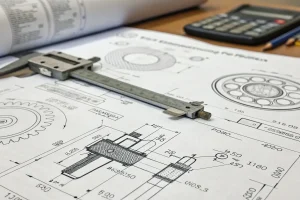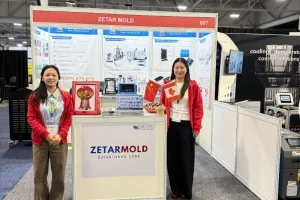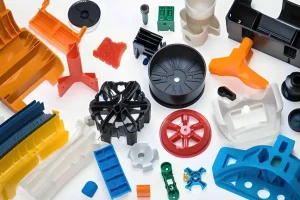In today’s manufacturing industry, injection molds play a crucial role and are used across various sectors such as electronics, automotive, medical and household appliances. The price of products is directly impacted by how much it costs to make the molds that produce them. This means that a company’s competitiveness in the marketplace can also be affected by these manufacturing costs. For this reason alone, it’s important for businesses to understand what factors influence spending on these items so they can not only control spending but also improve efficiency.

When considering the cost of injection molds, several variables significantly influence the outcome. The plastic injection molding process is a key factor as it dictates the complexity and cost of manufacturing process. Another crucial determinant is the choice of injection molding service providers, each differing in pricing and technological support. Additionally, specific attributes of the injection molding project itself—such as its complexity, required materials, and production scale—also impact the final injection molding cost. Therefore, understanding how these variables interact is essential for effectively managing and budgeting for injection mold costs.
In this article we take an in-depth look at some of the key drivers behind plastic injection mold pricing: material choice; design features; type of processing technology employed; volume levels for production runs;, how long each cycle time takes along with upkeep or maintenance schedules.We will also consider factors like the technical capabilities of manufacturers themselves as well any environmental issues which may drive up prices further.

Mold Materials
Mold materials are the foundation of injection mold cost. Different materials have significant price differences and directly impact the performance, lifespan, and maintenance costs of the molds.
Steel
Steel stands out as the most frequently used material in molds thanks to its impressive strength, great resistance to wear plus how easily manufacturer can shape it. Steel comes in many varieties. Different types of steel are suitable for different mold applications due to their varying properties and costs.
P20 Steel: This steel has good toughness and machinability. It can be used for molds in the low- or mid-market, especially when they require heat treatment. Its moderate price and high cost-performance ratio make it ideal for medium-sized molds in mass production.

718 Steel: 718 Steel is recognized for its superior hardness, great wear resistance and impressive ability to be polished. This type of steel is used in mid- to high-end molds. One of the benefits of using 718 steel is that it does not need extra heat treatment, so it can be used right away when making precision molds.
H13 Steel: H13 Steel has very high hardness and wear resistance, as well as good thermal stability: all key characteristics if you’re making molds at the upper end of the scale. H13 steel is commonly used for molding high-temperature materials and high-precision products.

Aluminum
Aluminum is used in specific scenarios due to its lightweight, good thermal conductivity, and excellent processing performance, especially for trial production and small-batch production.
Lightweight and Efficient: Compared with steel molds, aluminum molds are both lightweight and efficient. This means less stress on the injection molding machine, resulting in a leaner production.
Good Thermal Conductivity: Aluminum has excellent thermal conductivity, so aluminum molds cool faster than steel molds, improving manufacturing efficiency.
Low Processing Costs: Because it can be worked more easily and machined in less time overall expenses for producing an initial batch of them are significantly reduced.
However, aluminum has lower wear resistance and strength, resulting in a shorter lifespan and higher maintenance and replacement frequency, making it suitable for products with low durability requirements.

Alloy Materials
Alloy materials marry the perks of multiple metals. This means they are very hard and strong, plus resistant to rust. Because of these qualities, alloy is great for making precision molds.
High Performance: Alloy molds have superior performance, meeting the needs of complex, high-precision product production.
High Cost: Alloy materials are expensive and challenging to process, requiring higher technical and equipment investment, increasing manufacturing costs.
To choose the right option at the best possible price-performanceratio enterprises creating such items will therefore need to think carefully about their individual needs as well as how many units they plan on making and of course set budgets.

Mold Design
When manufacturing an injection mold, mold design is critical. It affects how well the mold will perform, how efficiently it will produce, and how long it will last. With a good design, manufacturing costs may be reduced while production capacity can be increased and overall product quality can be improved.
Mold Structure
The more complex the mold structure, the more it costs to make things. This is because complex mold structures require more processing steps and higher precision, increasing manufacturing difficulty and costs.
Multi-cavity Molds: These molds can produce multiple products simultaneously, increasing production efficiency. However there may be problems with how they are designed or made that only become clear later on; each one will also be more expensive than those produced by simpler molds.
Complex Slide and Core-pulling Mechanisms: These structures allow for the molding of complex products but increase the design and manufacturing difficulty and plastic injection molding costs.

Product Design
Product design rationality affects mold design complexity and cost. More sensible product design can streamline mold structure, cutting manufacture costs.
Optimized Product Design: Complex structures are not needed in some products; this is why the chances of having difficult molds should be eschewed since it only complicates things.
Design for Manufacturability: In many cases, designers overlook the mold manufacturing issues in the early stage of producing a final product, leading to inefficient mold construction and a short mold life cycle; thus, it is crucial to avoid the worst-case scenarios in the initial stages of product design.

Mold Precision
High-precision molds require higher machining accuracy and stricter quality control, increasing mold costs.
High Precision Requirements: When making precision products like medical devices or electronics that necessitate a higher level of both design innovation as well as manufacturing expertise. Resulting in higher design and manufacturing costs.
Quality Control: Strict quality control systems ensure that each stage of mold manufacturing meets high standards, increasing costs but enhancing mold lifespan and production efficiency.
By optimizing mold design, companies can reduce manufacturing costs while improving production efficiency and product quality.

Processing Technology
Picking the right processing tech can change your mold costs. Even though fancier technologies often mean better quality molds and faster production, they also tend to be more expensive overall.
CNC Machining
CNC machining gear achieves top precision and efficiency. This lowers human error while boosting mold consistency and accuracy.
High Precision and Efficiency: Complex shapes and ultra-precise mold processing are routine with CNC machining; overall production efficiency and mold quality gain substantially.
High Cost: CNC machining equipment requires significant investment, high maintenance costs, and skilled operators, increasing mold manufacturing costs.

EDM (Electrical Discharge Machining)
EDM is great for working with hard materials that need to be shaped in a complex way. It might take longer than other methods but it can achieve precision details that traditional methods cannot.
Processing Precision Details: EDM achieves high precision and complex shapes, suitable for high-hardness materials and precision molds.
Lower Efficiency: EDM efficiency is lower, with longer processing times and higher costs, but its precision and complexity advantages offset this drawback.

Grinding
Grinding is a popular way of finishing when making moulds. It gives high precision dimensions and very good surface quality.
High Precision: This controls the dimensions precisely, optimizes the surfaces to improve mold performance or service life and cuts down on manufacturing costs.
High Cost: They are expensive to acquire and maintain but they are accurate and yield better surface finishes that are the reason they have found their way to industries especially in making high precision molds.

Heat Treatment
Heat treatment processes can improve the hardness and wear resistance of mold materials, extending mold lifespan.
1. Improving Hardness and Wear Resistance: Through quenching, tempering, and surface hardening, heat treatment significantly enhances mold material performance.
2. Increasing Costs: Heat treatment processes increase mold manufacturing costs but improve mold lifespan and production efficiency, reducing long-term costs.

Production Volume
Production volume is a key factor affecting mold costs. Mass production can dilute fixed mold costs, improving economic efficiency.
Mass Production
In high volume production, fixed mold costs are divided among each product, which lowers the per-unit cost of each item.
Cost Dilution: Due to cost dilution, fixed mold costs make up a smaller percentage of an item’s overall expenses when it is mass-produced, this can also boost productivity rates.
High-Quality Mold Requirements: Mass production typically requires high-quality, long-lasting molds to minimize downtime and maintenance costs.

Small Batch Production
In small batch manufacturing, fixed mold costs are difficult to spread out, leading to higher costs per product.
Low Initial Investment: Small batch production is great for responding fast to what buyers want or making a model of a new product and doesn’t need lots of money upfront either.
Higher Costs: Due to the small production volume, fixed mold costs are harder to dilute, resulting in higher per-unit product costs, suitable for uncertain market demands or short product life cycles.
Companies need to plan production volumes reasonably based on market demands and production plans to achieve the best cost-benefit balance.

Manufacturing Cycle
The duration of the mold production process has a direct effect on how much capital a company is using as well as their speed in responding to the market. If you make these cycles shorter it can help you be more competitive but there may be an increase cost involved as well.
Rapid Manufacturing
Rapid mold manufacturing requires advanced processing equipment and efficient management processes.
Advanced Technology: State-of-the-art tools such as CNC machining, rapid prototyping, and concurrent engineering can cut the manufacturing cycle, helping firms respond more quickly to market opportunities.
High Costs: Because companies need to invest in both gear and new ways of working, setting up this kind of operation is costly and running it can be too.

Traditional Manufacturing
Traditional manufacturing methods have longer cycles but lower costs.
Lower Costs: Business life cycle low cost manufacturing techniques indicate that traditional manufacturing modes can easily be adopted is they require low equipment investments with low operating costs and are suitable for products that do not need to be in the market immediately.
Longer Cycles: Long manufacturing cycles are incurred and they reduce market response speed; adopted in organizations with products with longer life cycles.
Companies need to choose suitable manufacturing cycles based on product market demands and life cycles to achieve the best balance of cost and market response speed.

Maintenance and Upkeep
Maintaining and servicing molds has a direct effect on how long they last and how efficiently they churn out products. You can make molds last longer, have fewer hiccups during production and spend less money overall—just by keeping them in good shape.
Regular Maintenance
Routine maintenance involves cleaning, lubricating, and examining mold parts for defects. By catching and fixing problems early, keep small issues from becoming big headaches.
Preventive Maintenance: Preventative maintenance stops molds from breaking down; as a result, they last longer and jobs get done faster.
Maintenance Costs: While it’s true that regular upkeep raises overall expenses, it also cuts way down on what you’ll spend to fix or replace broken machinery.

Failure Repairs
Failure repairs involve fixing molds when issues arise.
High Costs: Failure repairs are usually costly and affect production schedules, increasing production downtime.
Production Efficiency Impact: Mold failure repairs impact production efficiency, increasing downtime and affecting production plans.
Companies should emphasize regular mold maintenance to reduce failure repair frequency and costs, improving long-term efficiency and reducing costs.

Technical Level of the Manufacturer
Mold costs are heavily influenced by the technical capabilities of the manufacturer. Those with advanced skills can produce top-quality molds that last longer, that means although buying them costs more initially, they work out better value over time.
Design Capability
Professionals can use their mold design expertise to improve the way molds are built. This boosts efficiency and means they last longer.
Advanced Design Software: Specially-developed computer programs and other tools also help make mold design more exact and faster.
Experienced Engineers: Experienced mold design engineers can design optimized mold structures based on product requirements, enhancing production efficiency and lifespan.

Processing Capability
Top-notch processing equipment and advanced processing technology form the bedrock of producing high-caliber molds.
Precision Processing Equipment: By employing precision processing equipment, manufacturers can boost molding accuracy and surface quality while also curbing processing gaffes and defects.
Automated Production Lines: Automated production lines don’t just cut down on human error—they also ramp up both efficiency (making things quicker) and product quality, with lower production costs as an added bonus.
Skilled Operators: Skilled operators further improve processing accuracy as well as overall efficiencies; this means fewer failures during production runs plus decreased maintenance costs overall.

Quality Control
The implementation of rigorous quality control measures in each phase of mold production guarantee that the final product meets high standards across-the-board.
Total Quality Management: Total quality management goes one step further with checks at every level – from examining raw materials to monitoring processes and inspecting final products. When these criteria are applied strictly throughout, overall mold quality increases.
Quality Inspection Equipment: Advanced equipment can make inspections more accurate and faster than manual inspections, thereby improving reliability and efficiency.
By choosing mold manufacturers with high technical levels, companies can improve mold quality and lifespan, reducing long-term costs and maintenance expenses.

External Environmental Factors
External environmental factors also affect mold costs, including economic environment, policy regulations, and market demands.
Economic Environment
Fluctuations in the economy can influence the prices of raw materials, costs of labor, and investments in equipment, which in turn affect the cost of molds.
Economic Upturn: During economic upturns, raw material and labor costs rise, increasing mold costs, requiring companies to face higher cost pressures.
Economic Downturn: During economic downturns, companies may face cost reduction pressures, requiring measures to lower mold costs to maintain competitiveness.

Policy Regulations
Policy regulations impact the mold industry mainly through environmental and safety standards.
Environmental Requirements: There are strict environmental requirements that companies have to adhere to, which can push up both manufacturing costs and the price of materials needed to make molds.
Safety Standards: Safety standards require companies to invest more resources in design and manufacturing to ensure product safety, increasing mold manufacturing costs.

Market Demand
Changes in market demand impact production planning for companies as well as their decisions on investing in molds.
Strong Market Demand: If the market is booming, businesses might want to invest more in molds so they can produce more and take advantage of this.
Weak Market Demand: In periods of weak market demand, companies may reduce mold investments to lower costs and avoid excessive capital utilization.

Conclusion
The cost of plastic injection molds is determined by many factors. These factors include mold materials, design and processing technology, and production volume. Other important considerations include manufacturing cycle, maintenance requirements, the level of expertise required by external manufacturers, and environmental impacts such as weather conditions or regulations. When making mold investment and manufacturing decisions, companies need to consider these factors comprehensively and balance various costs and benefits.

By logically selecting materials for molds, refining mold designs, using cutting-edge production technologies, planning manufacturing cycles and production volumes sensibly, improving maintenance schedules for molds, choosing manufacturers of high-quality molds – companies can better control costs associated with molds; enhance both quality levels and production efficiencies (thereby becoming more competitive in markets).










